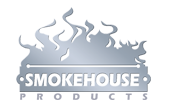THE MEAT: Brisket is that floppy part of the beef that hangs down under the cows neck and back toward their shoulder. It is a relatively inexpensive cut of meat and is very tasty when properly prepared. You can usually buy brisket with the "point/tip" on or trimmed. The point/tip is a larger end of the cut that is usually quite a bit thicker and fattier, thus making for a much larger piece of meat. I usually buy this cut because it is less expansive than the trimmed and because I have a plan for the point after my brisket is cooked. More about that later. Briskets are usually going to be in the 7-15 lb. range and there is a bit of shrinkage as the fat cooks away during your smokin' process.
THE RUB: Smokehouse Products has an excellent rub or there are numerous ones available from your grocer. However, you may choose to make your own rub. A good generic start is to combine 3 parts Lawry's Season Salt with 1 part Tony Chachere's Original Creole Seasoning. This combination makes a good, mild rub. If your taste buds are hankering for a little more bite, hello crushed red pepper. Your call. Rubs are very personal as far as taste is concerned, but be sure to take into consideration who else will be sharing your brisket.
THE PROCESS: If you desire, you may want to trim some of the extra fat off before you put on the rub. Some folks like to sprinkle water, apple juice, or Worchestershire sauce on the meat before applying their rub. Those are all good choices. Liberally apply your rub to the meat, lean side up-fat side down-first. How much to apply is a personal preference, but you will literally rub it into the meat, going with the grain. Allow the rub to sit at least 30 minutes. Some people like to let it sit overnight, but to me it gets saltier the longer it sits. While the rub is sitting is usually a good time to get your smoker ready; hook up the heat source, put your racks in, get the drip pan ready, put your wood in the chip pan. I like to use the mesquite pellets on my brisket, but I have also used apple wood chunks too. So, put the meat on the racks now, lean side down-fat side up. Apply your rub again, probably more on this side than you did on the lean side. Now... let's put the heat to the meat! Start out at about 150 to 200 on temperature for about 2 to 2-1/2 hours. We really are just interested in smokin' right now and not necessarily cookin' (there are some time and temperature variables here becuase of the different sizes of the meat). At about 2-1/2 to 3 hours, turn the temp up to 250 for about 5-1/2 more hours. Now we are smokin' and cookin'. Take a sample slide into the meat; if it's too red for your taste, cook longer. If it's medium done, take it off, wrap it in heavy duty foil and put it back on for another 2-3 hours. Be careful when taking the package off the smoker. It will be full of hot grease. Be prepared for that. Now, remember that point we left on? If you don't want to eat it now, cut it off and wrap it well and put it in the freezer. The next time you make vegetable soup, chop up some of that piece of meat and put it in the soup. Now you have Brisket Soup. Mmmm... you heard it here first! Time to ring the dinner bell... it's time to eat! Let us know how it turns out or if you have any questions.




Some of the recipes, such as Glenn’s Texas Smoked Brisket, are made using the Smokehouse Gas Smoker which has adjustable temperatures running up to 550 F.
Why do most of the recipes on this site involved changing the temp on the smoker? The temp is fixed on the smokers.
I grew up in Cincinnati, now I live in Jacksonville, FL…..Firehouse was started in Jacksonville in 1994 by acatul firefighters! The Datil pepper sauce is amazing! It’s a sweet, hot pepper that comes from the north Florida area.